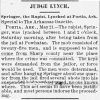calsfoundation@cals.org
Powhatan Courthouse
The Powhatan Historic Courthouse is located in the Powhatan Historic State Park, a stretch of a nineteenth-century river port town, and represents the rich judicial history and healthy commerce of northeastern Arkansas. It stands on a hill overlooking the Black River, not far from a collection of buildings that Arkansas State Parks also controls: the Powhatan Jail, the Ficklin-Imboden House, a commercial building, and the Powhatan Male and Female Academy. The Arkansas Historic Preservation Program recognizes the courthouse as significant for Lawrence County’s history, while also serving as a good example of historic preservation. It was added to the National Register of Historic Places on February 16, 1970.
In 1869, Lawrence County voters approved moving their county seat from the plantation community of Clover Bend (Lawrence County) to Powhatan (Lawrence County), a town established and maintained to exploit the Black River’s steamboat traffic. The county dispatched three commissioners to purchase land for the new courthouse in 1871, which local historian Warren McLeod described as an “old hill on which [the building] seems designed by nature for it.” With a $16,000 appropriation making up the budget, the architectural firm of Thornton and Jones of Little Rock (Pulaski County) designed Powhatan’s first courthouse, a two-story building made of native stone, with offices on the first floor and a courtroom on the second. To get there, many had to cross the Black River and pay ferriage fees, which residents raged about until a court order lowered the fares. Construction was completed on June 16, 1873, and the building stood for a dozen years until it burned, leaving an empty hill. However, county records dating back to 1813, when Lawrence County once stretched across the bulk of northern Arkansas, were safe in a fireproof vault.
County Commissioner James P. Coffin led the effort to rebuild with an appropriation of $12,000. Architect D. A. McKinnon came from Paducah, Kentucky, with his plans of an Italianate-style courthouse of red brick, arched windows, and a single bell tower. Italianate influence is seen throughout the building, both inside and outside, with brackets, dormers, and a modified mansard roof among the features. The courtroom is on the second floor and includes a high, crimson-colored ceiling, and wainscoting that matches the furniture. The contracting firm Boon and McGinnis erected the courthouse on the same site and used undamaged bricks from the fire-struck 1873 building.
During the construction process in 1887, the Arkansas General Assembly passed legislation splitting Lawrence County into two judicial districts, with Powhatan managing the western judicial district and Walnut Ridge (Lawrence County) becoming a second county seat for residents in the east. The standing Powhatan courthouse opened in 1888 and housed many notable cases on its dockets over the years, including the trials of alleged murderers, disgraced bankers, and crooked sheriffs.
Powhatan, the town that thrived on river traffic, began to decline when commerce shifted to railroads; this benefited the likes of nearby Black Rock (Lawrence County). The state legislature considered moving Powhatan’s county seat to the rail community of Black Rock in 1903, and three ballot initiatives failed over the decades. Powhatan endured with a dwindling population until 1963, when Lawrence County voters finally consolidated its county seats to Walnut Ridge.
In 1970, residents of northeastern Arkansas showed interest in preserving Powhatan’s history. The Powhatan Courthouse Restoration Association, as well as the Lawrence County Historical Society, began work to convert the defunct courthouse into a historic site. The Arkansas Department of Parks and Tourism assumed ownership in 1979, and additional restorations commenced, such as a 2005 project that included an advanced paint analysis in an effort to return interior walls to their original color.
The courthouse holds local folk history as well, with visitors taking “Ghost Tours” in hope of seeing rumored apparitions of the town’s former residents and those accused of crimes. This includes Andrew Springer, who allegedly assaulted a woman in 1887. A mob dragged him out of his cell one evening and hanged him.
For additional information:
“Historical Note.” Northwest Arkansas Times, March 31, 1972, p. 4.
Mother of Counties: History and Families. Paducah, KY: Turner Publishing Company, 2001.
“New Courthouse and One County Seat Up for Decision in Lawrence County.” Northwest Arkansas Times, August 26, 1963, p. 2.
“Powhatan Court Has Heavy Docket.” Arkansas Gazette, January 8, 1923, p. 10.
“Powhatan Courthouse.” National Register of Historic Places nomination form. On file at Arkansas Historic Preservation Program, Little Rock, Arkansas. Online at http://www.arkansaspreservation.com/National-Register-Listings/PDF/LW0021.nr.pdf (accessed July 19, 2017).
Jared Craig
Arkansas Historic Preservation Program
 Lawrence County Courthouse
Lawrence County Courthouse Post-Reconstruction through the Gilded Age, 1875 through 1900
Post-Reconstruction through the Gilded Age, 1875 through 1900 Springer, Andrew (Lynching of)
Springer, Andrew (Lynching of) Powhatan Courthouse
Powhatan Courthouse  Powhatan Courthouse
Powhatan Courthouse 




Comments
No comments on this entry yet.